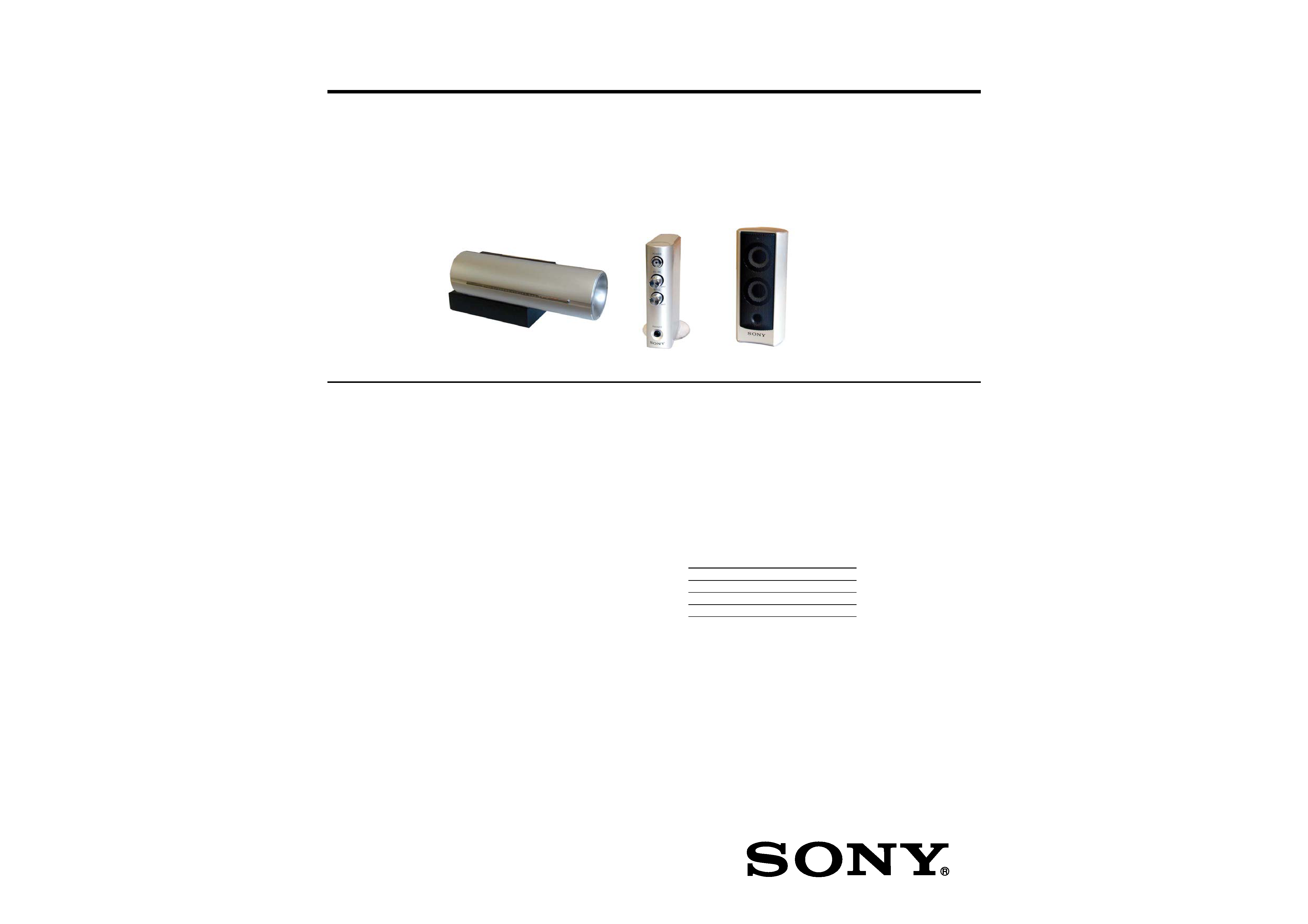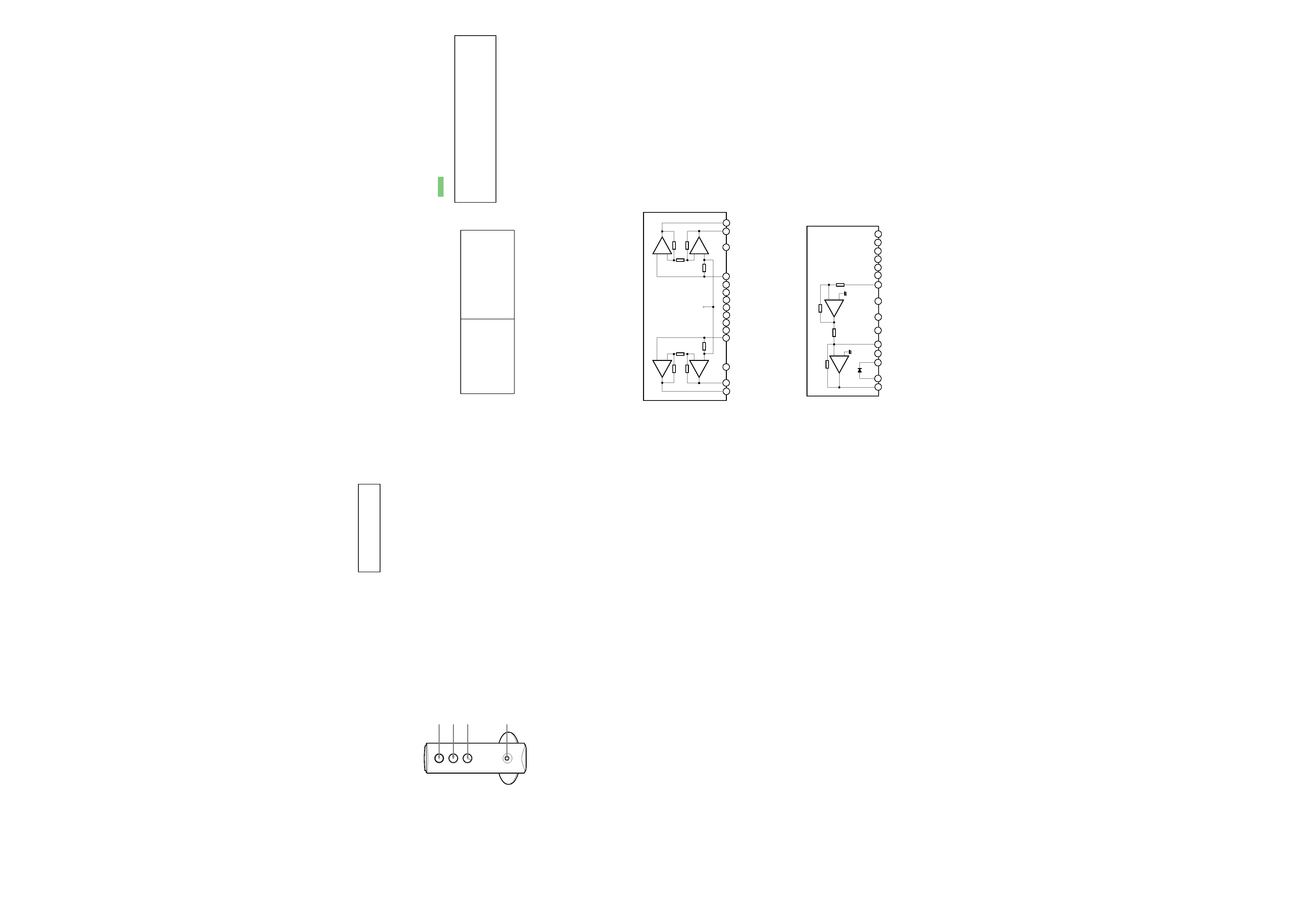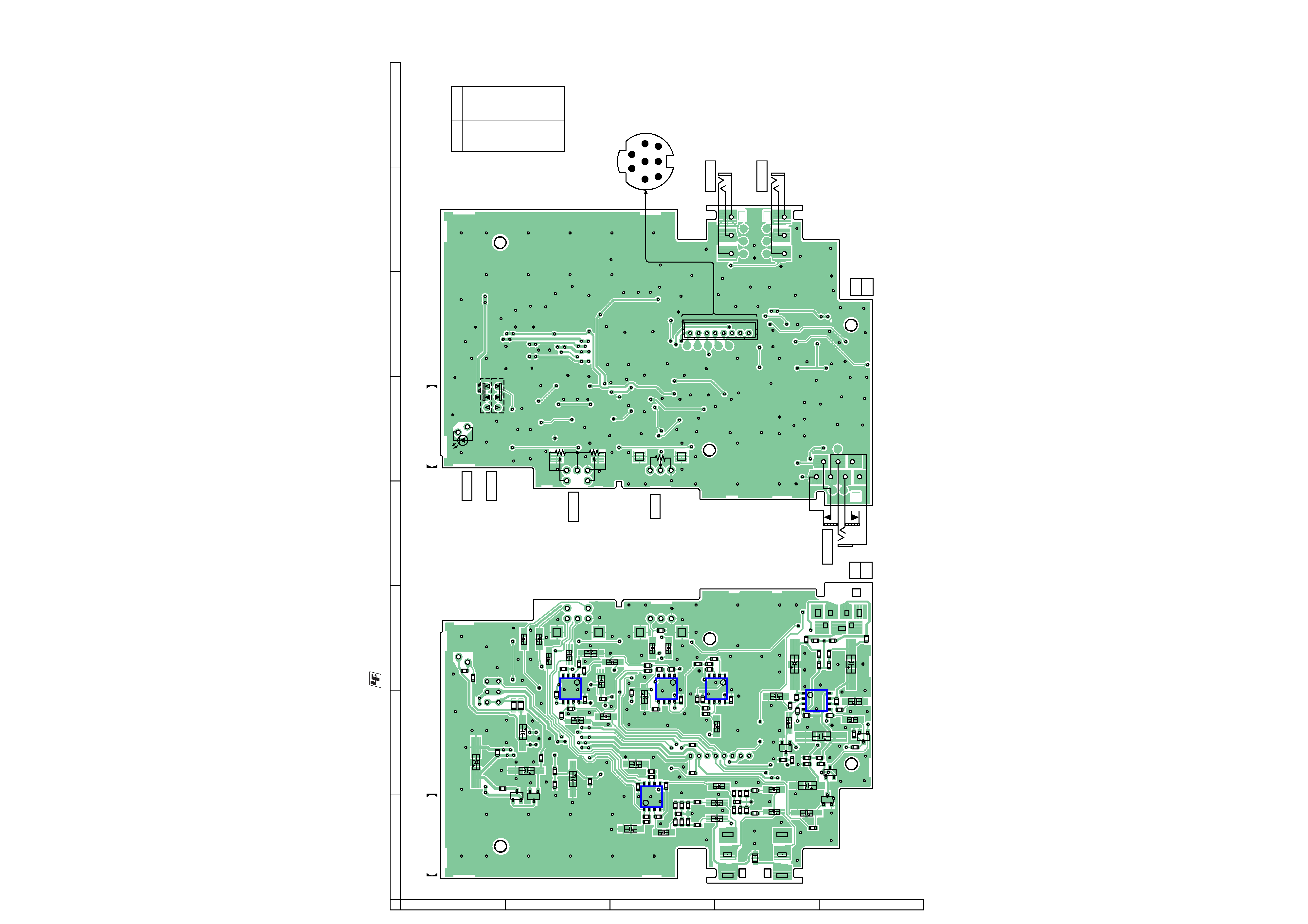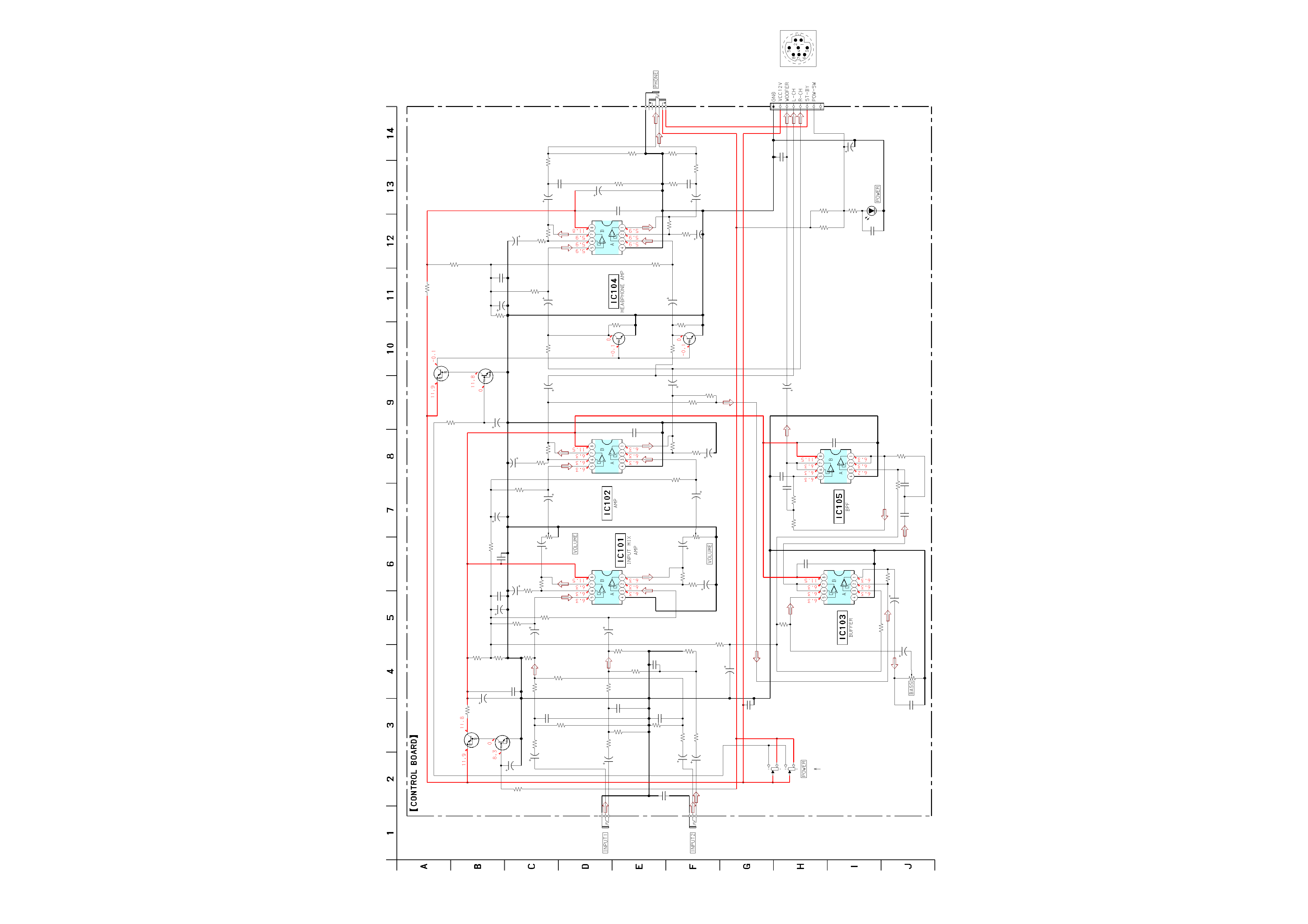
SRS-DZ10
US Model
Canadian Model
AEP Model
UK Model
SERVICE MANUAL
ACTIVE SPEAKER SYSTEM
Sony Corporation
Personal Audio Group
Published by Sony Engineering Corporation
9-879-587-02
2005E02-1
© 2005.05
SPECIFICATIONS
Subwoofer
Satellite
Speaker
Control Box
Ver. 1.1 2005.05
Speaker section
Satellite speaker
Speaker system
Magnetically shielded
Speaker units
3.9 cm, cone type (Sigma-type)
× 2
Enclosure type
Bass reflex
Impedance
8
Cord length
3 m
Subwoofer
Speaker system
Active subwoofer, magnetically shielded
Speaker units
7.7 cm, cone type (Sigma-type)
Enclosure type
Bass reflex
Impedance
8
Amplifier section
Rated output
6 W (10% T.H.D., 1 kHz, 8
) (Satellite speaker)
25 W (10% T.H.D., 100 Hz, 8
) (Subwoofer)
Input
Stereo mini jack
× 1 (INPUT 1)
Stereo mini jack
× 1 (INPUT 2)
Input impedance
4.7 k
(at 1 kHz)
Output
Stereo mini jack
× 1 (PHONES)
General
Dimensions (w/h/d)
Approx. 30
× 118.5 × 93.2 mm
(1 3/16
× 4 3/
4
× 3 3/
4 in.) (Control box)
Approx. ø62.8
× 142 mm
(2 1/2
× 5 in.) (Satellite speaker)
Approx. 375
× 151.5 × 183 mm
(14 7/8
× 6 × 7 1/
4 in.) (Subwoofer)
Mass
Approx. 146.5 g (6 oz.) (Control box)
Approx. 481 g (1 lb. 1 oz.) (Satellite speaker)
Approx. 4.1 kg (9 lb. 1 oz.) (Subwoofer)
Cord length
2 m (Control box to subwoofer)
2 m (Power cord)
Power requirements
Where purchased
Operating voltage
U.S.A./Canada
120 V AC, 60 Hz
European countries
220 - 230 V AC, 50 Hz
Other countries
220 - 230 V AC, 50 Hz
Power consumptions
19 W (US, Canadian)
24 W (AEP, UK)
Supplied accessories
Connecting cord, rubber feet
Design and specifications are subject to change without notice.

2
SRS-DZ10
TABLE OF CONTENTS
Specifications ............................................................................ 1
1.
GENERAL ................................................................... 3
2.
DIAGRAMS
2-1.
Printed Wiring Boards Control Section ...................... 4
2-2.
Schematic Diagram Control Section .......................... 5
2-3.
Printed Wiring Boards Amplifier Section (Side A) .... 6
2-4.
Printed Wiring Boards Amplifier Section (Side B) .... 7
2-5.
Schematic Diagram Amplifier Section ....................... 8
2-6.
Schematic Diagram Satellite Section ......................... 9
2-7.
Printed Wiring Boards Satellite Section ..................... 10
3.
EXPLODED VIEWS
3-1.
Amplifier Section ............................................................ 10
3-2.
Woofer Section ................................................................ 11
3-3.
Control Box Section ........................................................ 12
3-4.
Satellite Section ............................................................... 13
4.
ELECTRICAL PARTS LIST .................................. 14
SAFETY CHECK-OUT
After correcting the original service problem, perform the following
safety checks before releasing the set to the customer:
Check the antenna terminals, metal trim, "metallized" knobs, screws,
and all other exposed metal parts for AC leakage. Check leakage as
described below.
LEAKAGE
The AC leakage from any exposed metal part to earth Ground and
from all exposed metal parts to any exposed metal part having a
return to chassis, must not exceed 0.5 mA (500 microampers).
Leakage current can be measured by any one of three methods.
1. A commercial leakage tester, such as the Simpson 229 or RCA
WT-540A. Follow the manufacturers' instructions to use these
instruments.
2. A battery-operated AC milliammeter. The Data Precision 245
digital multimeter is suitable for this job.
3. Measuring the voltage drop across a resistor by means of a
VOM or battery-operated AC voltmeter. The "limit" indication
is 0.75 V, so analog meters must have an accurate low-voltage
scale. The Simpson 250 and Sanwa SH-63Trd are examples
of a passive VOM that is suitable. Nearly all battery operated
digital multimeters that have a 2V AC range are suitable. (See
Fig. A)
SAFETY-RELATED COMPONENT WARNING!!
COMPONENTS IDENTIFIED BY MARK 0 OR DOTTED LINE
WITH MARK 0 ON THE SCHEMATIC DIAGRAMS AND IN THE
PARTS LIST ARE CRITICAL TO SAFE OPERATION. REPLACE
THESE COMPONENTS WITH SONY PARTS WHOSE PART
NUMBERS APPEAR AS SHOWN IN THIS MANUAL OR IN
SUPPLEMENTS PUBLISHED BY SONY.
ATTENTION AU COMPOSANT AYANT RAPPORT
À LA SÉCURITÉ!!
LES COMPOSANTS IDENTIFIÉS PAR UNE MARQUE 0 SUR LES
DIAGRAMMES SCHÉMATIQUES ET LA LISTE DES PIÈCES
SONT CRITIQUES POUR LA SÉCURITÉ DE FONCTIONNEMENT.
NE REMPLACER CES COMPOSANTS QUE PAR DES PIÈCES
SONY DONT LES NUMÉROS SONT DONNÉS DANS CE MANUEL
OU DANS LES SUPPLÉMENTS PUBLIÉS PAR SONY.
To Exposed Metal
Parts on Set
0.15
µF
1.5 k
AC
Voltmeter
(0.75 V)
Earth Ground
Fig. A. Using an AC voltmeter to check AC leakage.
Unleaded solder
Boards requiring use of unleaded solder are printed with the lead
free mark (LF) indicating the solder contains no lead.
(Caution: Some printed circuit boards may not come printed with
the lead free mark due to their particular size.)
: LEAD FREE MARK
Unleaded solder has the following characteristics.
· Unleaded solder melts at a temperature about 40
°C higher than
ordinary solder.
Ordinary soldering irons can be used but the iron tip has to be
applied to the solder joint for a slightly longer time.
Soldering irons using a temperature regulator should be set to
about 350
°C.
Caution: The printed pattern (copper foil) may peel away if
the heated tip is applied for too long, so be careful!
· Strong viscosity
Unleaded solder is more viscous (sticky, less prone to flow)
than ordinary solder so use caution not to let solder bridges
occur such as on IC pins, etc.
· Usable with ordinary solder
It is best to use only unleaded solder but unleaded solder may
also be added to ordinary solder.

SRS-DZ10
3
3
SRS-DZ10
SECTION 1
GENERAL
This section is extracted
from instruction manual.
LOCATING THE CONTROLS
SECTION 2
DIAGRAMS
For schematic diagrams.
Note:
· All capacitors are in
µF unless otherwise noted. (p: pF) 50 WV or
less are not indicated except for electrolytics and tantalums.
· All resistors are in
and 1/4 W or less unless otherwise specified.
· C : panel designation.
· A : B+ Line.
· B : B Line.
·Voltages are dc with respect to ground under no-signal conditions.
· no mark : Power on
·Voltages are taken with a VOM (Input impedance 10 M
).
Voltage variations may be noted due to normal production toler-
ances.
· Signal path.
F
: AUDIO
THIS NOTE IS COMMON FOR PRINTED WIRING BOARDS AND SCHEMATIC DIAGRAMS.
(In addition to this necessary note is printed in each block.)
Note:
The components identi-
fied by mark 0 or dotted
line with mark 0 are criti-
cal for safety.
Replace only with part
number specified.
Note:
Les composants identifiés par
une marque 0 sont critiques
pour la sécurité.
Ne les remplacer que par une
piéce portant le numéro
spécifié.
POWER
VOLUME
BASS
PHONES
MAX
MIN
MAX
MIN
POWER
VOLUME
PHONES
Control Box
VOLUME: Controls total volume level.
BASS: Adjusts bass level (Subwoofer).
PHONES: Connect to headphones for personal listening.
BASS
For printed wiring boards.
Note:
· X : parts extracted from the component side.
·
: Pattern from the side which enables seeing.
(The other layers' patterns are not indicated.)
IC301 TDA7297
· IC Block Diagram
1
4
2
3
5
6
+
+
7
8
9 10 11
15
12
14
13
+
+
OUT1+
OUT2+
OUT1-
OUT2-
VCC
VCC
IN1
IN2
OUTPUT
2
S-GND
PW
-GND
ST
-BY
MUTE
N.C.
N.C.
N.C.
Vref
IC302 TDA7482
1
4
2
3
5
6
+
+
7
8
9
10 11
15
12
14
13
OUT
BOOTDIODE
BOOT
VREG
FEEDCAP
IN
-VCC
SIGN
+VCC
SIGN
+VCC
POW
-VCC
POW
-VCC
POW
SGN-GND
ST
-BY/MUTE
FREQ
N.C.
Caution:
Parts face side:
Parts on the parts face side seen from
(Side A)
the parts face are indicated.
Pattern face side:
Parts on the pattern face side seen from
(Side B)
the pattern face are indicated.

SRS-DZ10
4
4
SRS-DZ10
2-1. PRINTED WIRING BOARD CONTROL SECTION
RV102
RV102
RV103
RV103
S101
S101
JK103
JK102
JK101
CN102
PHONES
POWER
D101
POWER
VOLUME
BASS
R352
R351
R331
C109
R322
R321
R318
R317
R316
C211
C209
C131
R303
C210
R302
R301
C201
C110
C111
C101
R234
R233
C103
C106
R232
R231
C112
C113
R217
R216
R215
C114
C115
C203
C206
R214
R212
R211
R210
R209
R208
R207
R204
R203
R202
R201
R134
R133
R132
R131
R117
R116
R115
R114
R112
R111
R110
R109
R108
R107
R104
R103 R102
R101
Q205
Q105
Q104
Q103
Q102
Q101
IC104
IC102
IC101
C369
C368
C332
C331
C330
C322
C321
C318
C317
C316
C315
C310
C304
C302
C301
C231
C215
C214
C213
C212
C323
C150
C151
C250
C251
C324
C370
R353
R354
IC105
C336
R118
R119
C303
C334
C333
C313
C309
R313
R219
R307
C319
R306
C216
R218
C325
C312
C326
C116
R310
R312
R325
R326
IC103
R323
R332
C371
R113
R213
E
E
E
E
E
E
1
1
1
1
1
4
4
4
4
4
5
5
5
5
5
8
8
8
8
8
INPUT 1
INPUT 2
CONTROL BOARD (SIDE A)
11
(11)
1-867-133-
1
2
OFF
ON
t
1
8
1
7
6
2
3
4
5
8
11
(11)
1-867-133-
CONTROL BOARD (SIDE B)
2
3
4
5
6
7
8
A
1
B
C
D
E
: Uses unleaded solder.
Ref. No.
Location
D101
A-5
IC101
C-1
IC102
B-3
IC103
C-2
IC104
D-2
IC105
D-3
Q101
E-2
Q102
E-1
Q103
B-1
Q104
B-1
Q105
E-2
Q205
D-2
· Semiconductor
Location

SRS-DZ10
5
5
SRS-DZ10
2-2. SCHEMATIC DIAGRAM CONTROL SECTION
R116
C114
R117
R115
C115
R307
R306
C211
R321
R302
C303
C304
R303
R301
C301
C302
R107
C103
R102
R202
C321
C101
R101
R133
R201
C201
R233
C131
R131
R134
R203
R232
R132
R234
C251
C250
C150
C323
C231
R231
C151
C368
R351
R332
R323
C333
C336
C310
C309
RV103
IC105
R312
C312
C313
R310
C334
C315
C326
C325
R326
R325
C371
R217
R216
C214
C215
R215
R214
C213
C212
R212
R210
R112
C112
R110
C316
C317
C113
R114
R317
R318
R316
C322
R322
C111
R352
C369
R109
C109
C106
C203
R207
R108
R104
RV102(1/2)
R204
C206
R208
RV102(2/2)
C209
C210
R209
C216
R218
R219
C370
R331
R354
R353
C330
D101
CN102
C319
C318
S101(1/2)
S101(2/2)
C110
R119
C116
R118
R211
R111
C332
C324
Q104
Q103
Q101
Q102
Q105
Q205
C331
R313
JK102
JK101
IC101
µPC4558G2
µPC4558G2
IC102
IC104
IC103
µPC4558G2
JK103
R103
R113
R213
4.7
220
6.3V
220
4.7
0.22
10k
10k
4.7
25V
4.7k
22
220
16V
0.1
5.6k
4.7k
100
6.3V
0.1
22k
4.7
25V
6.8k
6.8k
47
16V
4.7
25V
1k
4.7k
1k
4.7
25V
4.7k
4.7
25V
1k
4.7k
1k
6.8k
6.8k
4.7k
1000p
1000p
1000p
100p
4.7
25V
1k
1000p
10
16V
4.7k
22k
22k
0.1
4.7
25V
4.7
25V
0.1
10k
NJM4558M
100k
0.068
0.068
15k
0.1
4.7
25V
0.068
0.22
12k
15k
1000p
220
4.7
220
6.3V
0.22
4.7
1k
10
16V
4.7
25V
22k
10k
22k
4.7
25V
10k
100
6.3V
0.1
10
16V
1k
4.7k
4.7k
22
22
16V
10k
4.7
25V
4.7k
10
16V
22k
4.7
25V
10
16V
4.7
25V
22k
10k
1k
10kA
1k
10
16V
10k
10kA
4.7
25V
4.7
25V
22k
10
16V
6.8k
22k
47
16V
470
4.7
4.7
0.1
TLG124A
8P
220
16V
0.1
PUSH-SW
3-2
PUSH-SW
3-2
4.7
25V
22k
10
16V
6.8k
1.5k
1.5k
0.1
10
DTC114YKA
+B SWITCH
DTA114YKA
+B SWITCH
DTA114YKA
MUTE DRIVE
DTC114YKA
MUTE DRIVE
DTC343TK
MUTE
DTC343TK
MUTE
0.1
22k
NJM4580M-(TE2)
1k
10k
10k
8
1
OFF
ON
